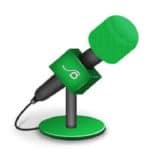Mics come in odd shapes and typically in all sizes that are specially developed for everything from spoken word environments to Kick drums and room ambiance. There is one specific type of mic that is used that has become more and more popular in musical recordings. It’s called a Boundary Microphone. What is a Boundary Microphone?
A Boundary microphone is a small omnidirectional condenser mic capsule positioned near or flushes with a boundary such as a wall or a floor. Used on Drums, Amps, Pianos & more. The arrangement provides a directional half-space pickup pattern while delivering a relatively phase-coherent output signal.
Boundary Microphones are known for flexibility and as a multi-purpose tool for capturing reflective sounds due to their size and shape which wasn’t practical in recording before.
What is a Boundary Mic Used For
A Boundary Mic is an omnidirectional microphone that is essentially a small diaphragm condenser mic mounted in a housing that directs the diaphragm parallel and flat to the surface onto which it’s mounted. The parallel setup allows the mic to pick up the sound that is reflected off the surface that it’s mounted to, essentially walls or tables any place in a room or space.
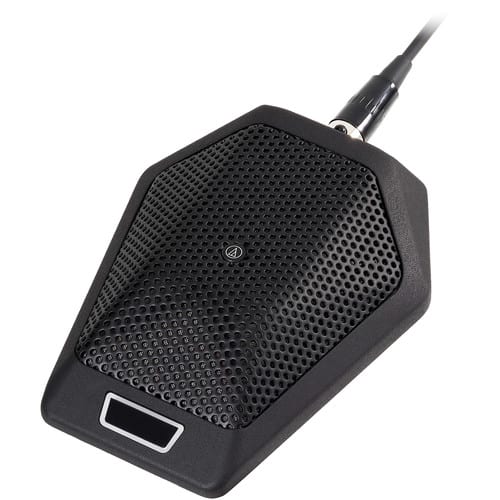
The best property that a Boundary Mic gives an advantage is that it can pick up sounds that are accurate in reverberant rooms along with capturing sounds from multiple sources.
In one scenario if you were talking to people in different parts of a conference room the Boundary Mic could pick up everything without the need of using multiple mics.
These mics are used in conference rooms recording meetings situated from tabletops or desks. Some are flush-mounted inside the furniture that actually built into the space. They are built into Churches or Halls as part of the communications making the rooms live that are stationary and not meant to be moved around generally designed for that space.

Normally Cardodid, Super-Cardioid (that is a little narrower), or Omnidirectional pattern. Boundary Microphones are fairly inexpensive. They come wired or wireless which gives them more flexibility in multi-purpose applications. Because a Conference Room has multiple audio sources.
The flat surface (such as an in-wall, table, or ceiling) is ideal because the boundary mic is made specifically to pick up sound that is reflected off the surface it’s on. Think of any time you need to pick up sounds from an entire room, such as business meetings, also see them in various other applications such as recording or amplifying pianos stationed under the open-top, sports like hockey boards for body check sound effects small musical ensembles with room acoustics, and more.
How Does a Boundary Mic Work
The Boundary Mic is nothing new or spectacular it’s basically a Condenser small-diaphragm with the capsule and internal circuits that can lay on a flat surface. If you don’t understand how you may benefit from a Boundary Mic read more about how this type of mic may have a pot among the ones that you own in your personal studio.
Being able to position this mic anywhere you may need to in the most unique spots can be a valuable tool. It creates various specific advantages, including the enhancement of its signal-to-noise ratio, as well as an increased suppression of ambient noise. Many things can work to your advantage because of this one advantage. An advantage that a regular-shaped mic doesn’t have.
A conventional mic that you placed on, or a few inches above, a hard boundary surface will pick up the desired direct sound as well as delayed sound reflecting off the boundary surface. This is good and bad. The direct and the reflective sound caused by the mic will cause Comb Filtering with constructive and destructive interference causing peaks and valleys in the frequency response. In other words, the sound will be dirty and interference will be amplified.
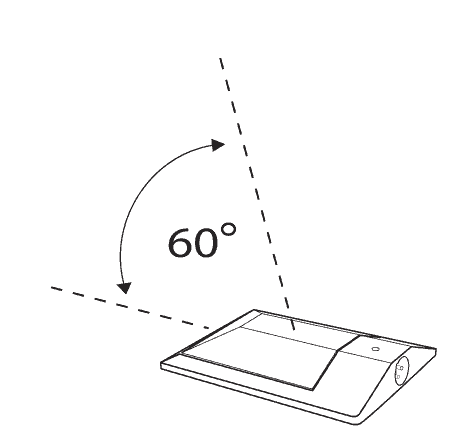
By placing the diaphragm of the microphone capsule parallel to and facing the plate(as in this picture) boundary provided by the microphone package, the reflected sound delay is lessened, along with the comb filter interference frequencies, and are high enough that you hear as much of it.
These types of microphones can pick up someone talking either in front of the microphone or in close proximity to the mic. These Directional Element Boundary Mics offer a cardioid pickup pattern that will capture sound from within a 120-degree angle of acceptance. And since the microphone is placed on a flat surface, 60 degrees of acceptance is in front and above the microphone, while the other 60 degrees are being used to pick up the reflections off of the flat surface it’s sitting on.
The direct pickup within the top 60 degrees and the reflective pickup are both in phase with each other which is considered PCC (Phase Coherent Cardioid.) This is also referred to as “half-cardioid” which indicates the pickup is cardioid in the hemisphere above the mounting surface.
PZM microphones
The term PZM means a Pressure Zone Microphone and was used by Crown and Radio Shack/Tandy to describe its own particular development of a boundary layer microphone design, in which the mic capsule is mounted slightly above the surface plate, looking back down onto it. Most Boundary Mics will simply mount the flat surface of the area you want to mic.
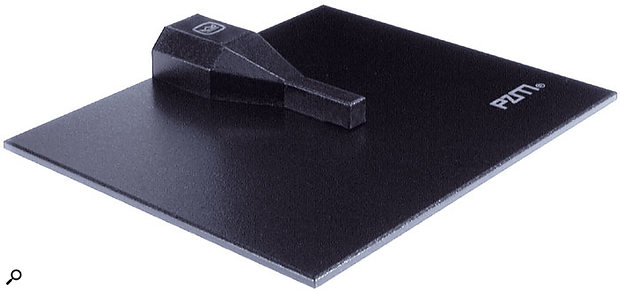
The PZM has a small omnidirectional capsule that is a few 1000’s of an inch above a flat plate that becomes part of the boundary layer when it is then connected to a surface that could be a wall, floor, soundboard, or even the ceiling. You can’t make it out in this picture but the capsule is slightly raised which can make a huge difference in the frequency response from the reflection of the sound waves.
When a sound wave reaches a fixed surface boundary — such as a wall — there is a pressure maximum (and velocity minimum) at the surface. Placing the microphone in this zone of pressure maxima gives a ‘free’ boost insensitivity of 6dB, which is handy. There are a number of applications that can be used with these mics like a mic under a piano lid.
A Stage Mouse or a Mic Mouse was developed by Electro-Voice and is often used in theatric productions this arrangement uses a Cardioid pattern mic and sits in a shock-absorbing cradle that holds the mic’s capsule very close to the surface of the floor. As the singers and actors speak, the sound waves travel across the boundary layer on the floor and are picked up by the Stage Mouse.
How Are NFL Football Players Mic’d Up
Recording Drums With A Boundary Mic
Miking a Cajon– One idea for miking a Cajon is to use a Boundary Mic for stage or recording. If you use the Boundary Drum microphones make sure that the hole in your Cajon is big enough to accept the microphone. The wide dynamic response of these microphones along with the almost total isolation for external sounds means a good sound combined with very low feedback potential. Most Boundary Mics that are quality mics have Low-End roll-off potential.
- Start in the Soundhole
- Move out of the hole in small increments
- Then farther 1-3 feet
It just makes everything a lot easier for everyone concerned. It makes perfect sense to use these mics directly into the soundhole especially now that the wireless Boundary Mics are available. No wires no fuss it’s just the way to go. You can place the Boundary into the Soundhole or 1-8 inches directly out front of the hole. Quality Boundary mics like
The Cajon is a cool instrument and able to generate low-frequency sonic content like a kick drum mostly from the back, where it has a sound hole and mid-to-high frequencies coming from the front, where the player uses his hands or brushes to cover all your “snare and hi-hat” parts.

Both exceptional sound for recording instruments and Room. The Shure is wireless how cool is that? Check them out! Experiment with the distance because every room and stage is different. Listen for these frequencies and move the Boundary or PZM mic in the area where you get what you are looking for. All you need are small incremental changes inside or outside the box.
Wireless Boundary Microphone
Miking a Kick Drum-Using a Boundary mic inside your Kick drum will add everything you have been dreaming it would do. The beefy response and low ends have never been so good since you’ve heard them from the inside of a Bass drum. Just fantastic low frequency added to a mic on the outside or stand-alone awesome!
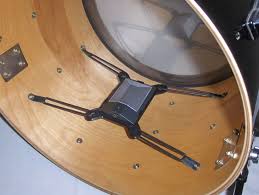
A lot of drummers are experimenting with these mics in recording spaces farther out, laying flat on the floor close enough to where they are being used as a Kick Drum mic but far enough out that they are being used as Room Microphones. Try some of these mic Placements:
- Inside the Kick Drum Taped flat down or use something to lay it down flat because of the curve it might be hard.
- 1 to 3 feet out front of Soundhole-Flat to the floor
- Farther back 5 to 6 feet from Soundhole
- Across the room lined up directly in front of the Bass Drum pointing to the opposite wall that the drums are facing- this will pick up reflective bounce sound low off the wall coming from the Kick adding it to the mikes on your kit.
- Boundary Mic taped on the wall directly across the room from the drum Kit- Any spot- try different ones. At different heights.
Boundary mics can give you creative ideas about where and how you want to collect frequencies in a room. The sky’s the limit. Remember man it’s all subjective. Start with the basic positions that are here in these articles and then find your own way.
My friends and I have no positions or placements for subjective spots. Take the time to record where you lay these Boundary mics out in a certain room chance is they’ll sound just as good the next time. I have put them on coffee tables or tapped them to the ceiling. Try everything!
I will be doing a post on Room miking soon. I will be giving some unique spots to use Boundary, PZM, and Standard mics in very unstandard places.
Of course, Drums are just one of the different kinds of instruments that you can mic with a Boundary Mic besides Vocals, Piano, and others with lots of attention being given to Room mics which we will cover in our next section.
Stereo Miking Techniques
JimGalloway Author/Editor
